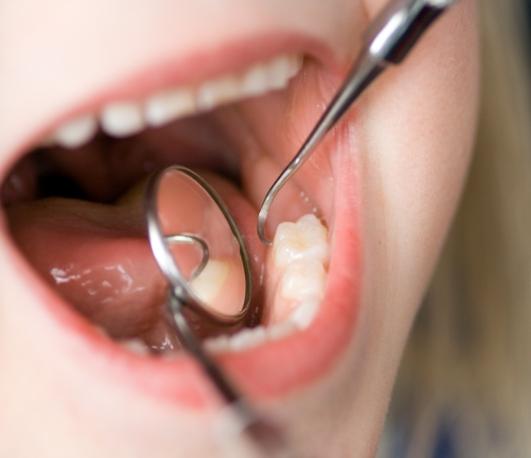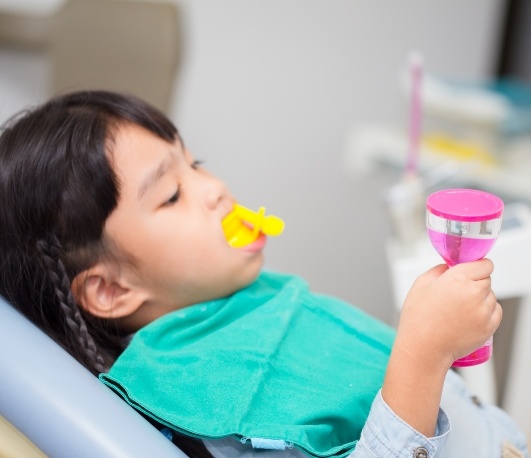Children’s Dentist Waco
Inspiring Young Smiles to Grow Healthy & Strong
At Heart of Texas Smiles General & Cosmetic Dentistry, our dental team knows how hard it can be to get your child excited about good oral hygiene. Their focus is on toys, video games, or playing outside, which can make the few minutes spent brushing, flossing, and rinsing feel like an eternity to a small child. Fortunately, we have the tools to help your little one maintain a healthy smile as they grow and develop into childhood and adolescence. We are even happy to provide helpful tips that will make practicing good oral health at home easier than ever before. Let us help you put your child’s smile on the right path by calling us to schedule an appointment today with our children's dentists in Waco!
Why Choose Heart of Texas Smiles General & Cosmetic Dentistry for Children’s Dentistry?
- All-Digital Dental X-Rays Safe for Children
- Only Practice in Waco to Offer HealthyStart™
- Dentists Who Are Advocates for Preventive Dental Care
When Should Your Child First Visit the Dentist?

It is recommended that your child’s first visit occurs when they are 6 months old or when their first tooth erupts. However, this initial visit isn’t as much about our team seeing your child for any possible problems. It is more about you, as the parent, understanding what to expect when you bring them in for a normal dental checkup and cleaning.
If you have been practicing good oral healthcare at home, it is possible to bring your child in at the age of 3 or 4. This is typically the age when they can sit still and have a better understanding of what is occurring.
Baby Bottle Tooth Decay Prevention

One of the most common dental problems seen in infants and toddlers is known as baby bottle tooth decay. This occurs when your child is exposed too long to drinks that contain sugar. If your baby is fussy or is having trouble going to sleep at night, you may be tempted to give them a bottle to help pacify them until they calm down or go to sleep. Unfortunately, the contents within the bottle can sit on their teeth too long and lead to tooth decay. To prevent this from happening, it is best if you:
- Wipe your child’s gums after each feeding with a damp cloth to remove any residue
- Once their teeth begin to erupt, use a small toothbrush and a smear (the size of a grain of rice) of toothpaste to clean their teeth
- When giving your baby a bottle, make sure it is only milk, breastmilk, or formula
- Avoid filling bottles with sugary drinks or juices
- Make sure your baby finishes their bottle before going to bed
Cavity Prevention for Older Children

It’s not just babies, toddlers, or even young children who are prone to tooth decay and cavities. Older children can easily develop them over time if poor oral hygiene occurs at home. Their baby teeth will not stay in forever but to make sure their permanent teeth come in correctly, these primary teeth must remain in good oral health. To achieve this, you can help your child by:
- Ensuring they brush their teeth twice daily for two minutes (once in the morning and once in the evening)
- Making sure they brush correctly between their teeth to remove bacteria and trapped food particles
- Not giving them too many sugary or starchy snacks throughout the day
- Maintaining their regular dental checkups and cleanings twice a year
Dental Sealants

Once your child’s permanent teeth are in place, we can provide another method of protection to prevent cavities from developing. It takes time for your child to develop the manual dexterity to effectively reach and brush their molars. Oftentimes, they are hard to reach, which is why dental sealants are an excellent way to protect these teeth from bacteria, plaque, and acids.
We will paint a clear, plastic-based liquid over the chewing surfaces of these teeth, allowing it to harden in place. As a result, this will prevent cavity-causing bacteria from penetrating the sealants and accessing the grooves and pits of your child’s molars.
Fluoride Treatment

Fluoride is a beneficial mineral found in toothpaste, food, and even water. It is known to strengthen tooth enamel and lower the risk of developing tooth decay, which is why dentists throughout the world provide an in-office fluoride treatment. While you might think your child is getting enough fluoride from these other sources, allowing our team to provide this type of treatment will only help to better protect their smile from tooth decay and cavities.
During a regular dental checkup, we can provide a topical fluoride treatment that will only take one minute to complete and is completely painless. It is also a great way to keep your child’s teeth protected, happy, and healthy in-between their appointments.
HealthyStart™

When a child struggles to achieve adequate sleep because of their inability to breathe, it may be that their teeth and/or bite are the problem. As the only dental practice in Waco to offer HealthyStart™, we can take a proactive approach to fix various orthodontic issues early on so that your child does not suffer more serious sleep-breathing disorders in the future.
I Need a Checkup & Cleaning I am Worried About Gum Disease I Have a Cavity or Broken Tooth I am Missing One or More Teeth I Want to Enhance My Smile I Want a Straighter Smile I am Scared of the Dentist I Have Jaw Pain I'm Having Trouble Sleeping I Have a Dental Emergency View Our Services

